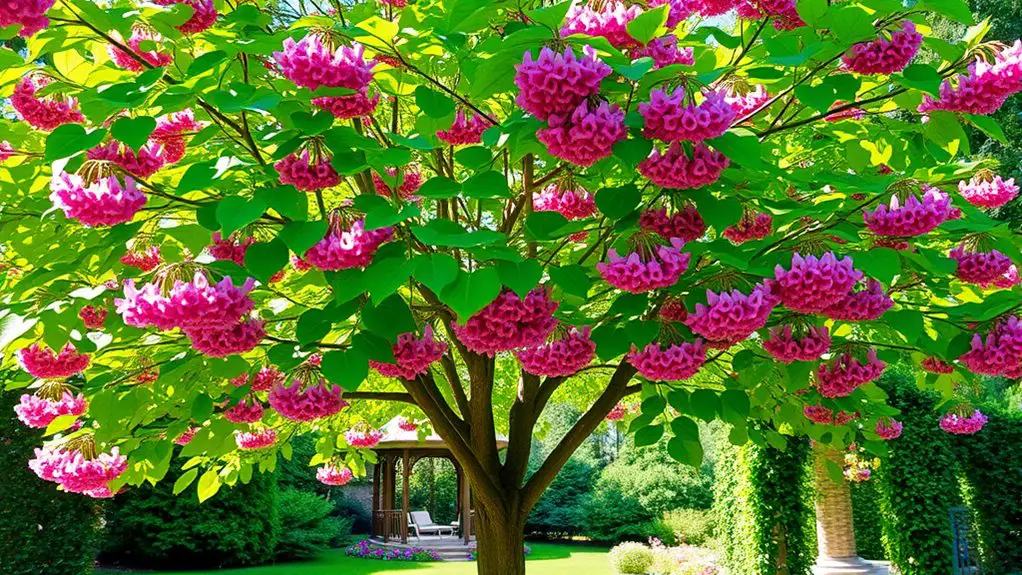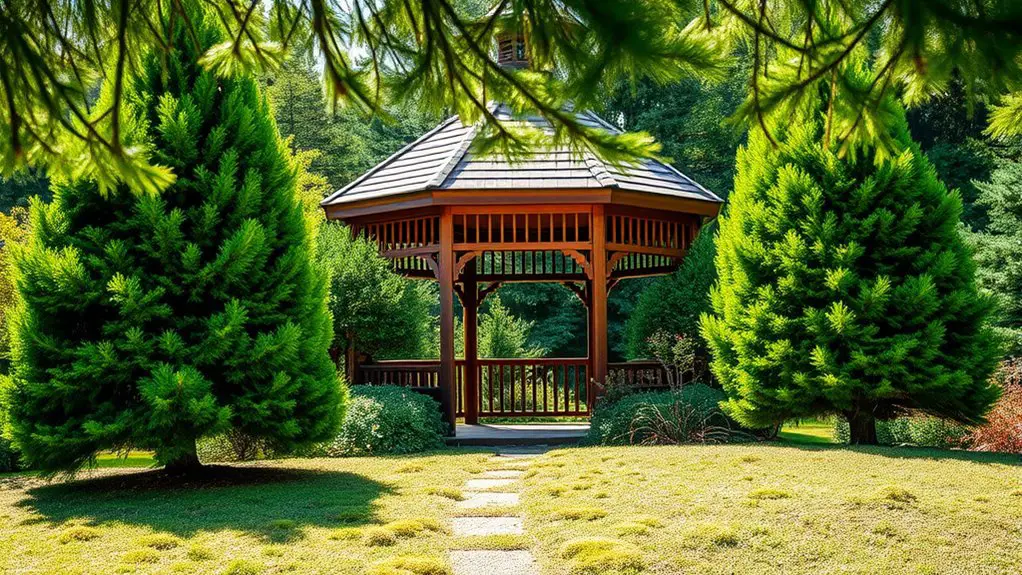For an enchanting gazebo surround, consider small trees like the Japanese Maple for its vibrant seasonal colors, or the Flowering Dogwood, known for its striking spring blooms. The heart-shaped leaves of the Redbud add charm, while the Hydrangea Tree brings lush blooms and versatility. Don’t overlook the Dwarf Alberta Spruce, perfect for year-round greenery. Each of these options elevates your outdoor space, creating a serene ambiance that invites exploration of nature’s beauty.
Japanese Maple: A Splash of Color

Japanese Maples are a stunning choice for adding vibrant color to your gazebo area. With their array of Japanese varieties, you can find a tree that perfectly complements your aesthetic vision. These trees exhibit delicate leaves that can range from deep burgundy to bright chartreuse, creating a dynamic visual throughout the seasons.
As the year progresses, you’ll witness breathtaking seasonal changes; the vivid greens of spring transform into fiery reds and oranges in autumn, offering an enchanting backdrop for your outdoor space. Their graceful branching structure and elegant silhouette enhance the overall ambiance, inviting you to relax and enjoy the serene environment.
Consider planting a Japanese Maple near your gazebo to create a natural, inviting atmosphere. With proper care, these small trees can thrive and become a cherished focal point, providing beauty and tranquility as you embrace the freedom of outdoor living.
Flowering Dogwood: Beauty in Bloom
If you’re seeking a tree that offers stunning seasonal displays alongside the elegance of a Japanese Maple, the Flowering Dogwood is an excellent option. Known for its striking blooms in spring, this tree adds a vibrant touch to your gazebo. With various dogwood varieties available, you can choose one that best suits your landscape.
| Season | Appearance |
|---|---|
| Spring | White or pink flowers in bloom |
| Summer | Lush green foliage |
| Fall | Rich red and purple leaves |
For ideal growth, seasonal maintenance is key. Regular pruning and mulching will enhance its aesthetic appeal and health. The Flowering Dogwood not only provides visual splendor but also creates a serene atmosphere, inviting you to enjoy the beauty of nature right from your gazebo.
Redbud: Heart-Shaped Leaves and Stunning Flowers

While many trees provide beauty, the Redbud stands out with its heart-shaped leaves and stunning floral display. This small tree, native to North America, bursts into a vibrant pink hue in early spring, creating a mesmerizing visual that complements any gazebo. The Redbud’s heart-shaped leaves emerge after the flowers, showcasing a rich green that adds texture and elegance throughout the growing season.
When considering Redbud care, make sure it receives well-drained soil and partial sunlight for peak growth. Be mindful of watering, especially during dry spells, to keep your tree healthy and thriving. There are several redbud varieties to choose from, including the Eastern Redbud and the Forest Pansy, each offering unique foliage and flower characteristics. By selecting the right variety and providing proper care, you’ll create a stunning focal point that enhances your outdoor sanctuary.
Hydrangea Tree: Lush Blooms and Versatility
Its rounded canopy provides dappled shade, creating a perfect retreat beneath your gazebo. For ideal growth and proliferation of those stunning blooms, follow essential tree maintenance tips such as regular pruning after flowering and ensuring well-draining soil.
Hydrangea Trees thrive in full sun to partial shade, adapting beautifully to various conditions. Their ability to flourish in different environments makes them a fantastic choice for any landscape. With their enchanting colors and textures, they’ll transform your gazebo area into a serene oasis.
Dwarf Alberta Spruce: A Classic Evergreen Choice

When you’re looking for a classic evergreen that complements the elegance of a gazebo, the Dwarf Alberta Spruce stands out as a top choice. This meticulously structured tree boasts a dense, conical shape, adding a touch of sophistication to any landscape. Its rich green foliage remains vibrant year-round, making it a stunning focal point.
Dwarf Alberta spruce care is straightforward; it thrives in well-drained soil and prefers full sun to partial shade. Regular watering during dry spells guarantees it maintains its lush appearance.
One of the dwarf Alberta spruce benefits is its slow growth, which means it won’t overpower your gazebo or surrounding plants. Additionally, its compact size makes it perfect for smaller spaces, allowing you to enjoy the beauty of evergreens without sacrificing freedom in your garden design. So, if you’re seeking a timeless addition, consider this exquisite tree for your outdoor oasis.
Frequently Asked Questions
What Is the Ideal Soil Type for Planting Small Trees?
When it comes to planting small trees, the ideal soil type’s vital. You’ll want well-draining soil rich in organic matter, ensuring proper soil drainage and ample tree nutrients to foster vibrant growth and stunning beauty.
How Much Sunlight Do These Trees Require?
These small trees have varied sunlight preferences, typically thriving in partial to full sunlight. Seasonal changes can affect their needs, so consider observing your space throughout the year to guarantee ideal growth and aesthetic appeal.
What Is the Average Growth Rate of These Trees?
Did you know some small trees can grow up to 24 inches annually? Understanding growth patterns helps you plan for tree maintenance, ensuring your space flourishes without overwhelming your surroundings or obstructing desired views.
Can These Trees Attract Pests or Diseases?
Yes, these trees can attract pests or diseases. You’ll need effective pest control and disease prevention strategies to maintain their health, ensuring they flourish without compromising the aesthetic beauty and serenity of your outdoor space.
How Far Should I Plant These Trees From the Gazebo?
When considering tree placement, you’ll want to maintain at least 5 to 10 feet spacing from the gazebo. This distance guarantees proper growth, airflow, and aesthetics, enhancing both your garden’s beauty and the gazebo’s charm.

